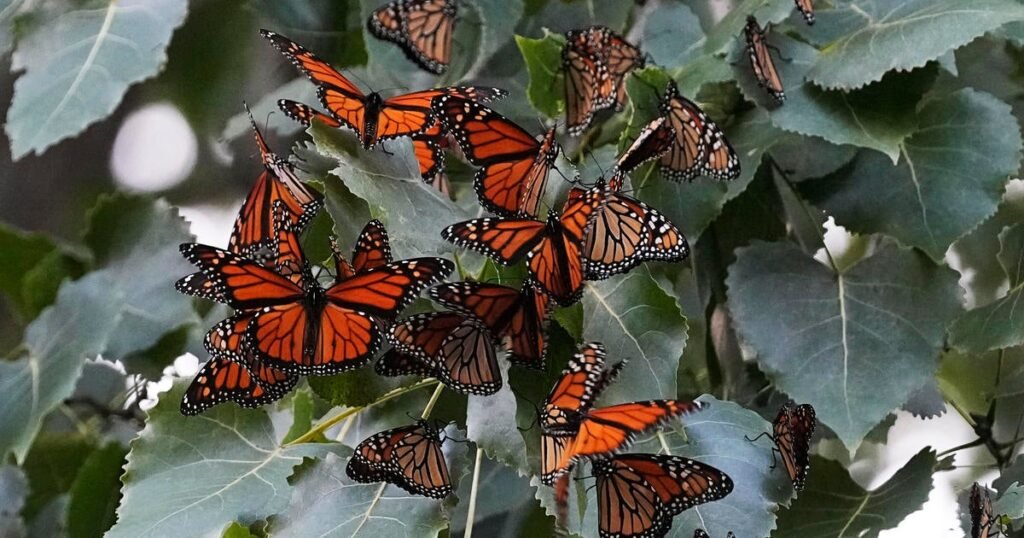The number of monarch butterflies spending the winter in the western United States has dropped to its second-lowest mark in nearly three decades as pesticides, diminishing habitat and climate change take their toll on the beloved pollinator.
Here’s what to know:
Endangered species
Monarch butterflies, known for their distinctive orange-and-black wings, are found across North America. Monarchs in the eastern United States spend their winters in Mexico and are counted by the World Wildlife Fund, which has yet to release data for this year. Monarchs west of the Rocky Mountains typically overwinter along the California coast.
They were officially designated an endangered species by the International Union for the Conservation of Nature in 2022, when estimates suggested populations could have dropped as much as 72% over the course of a decade.
Sue Ogrocki / AP
The Xerces Society for Invertebrate Conservation has been counting western overwinter populations along the California coast, northern Baja California and inland sites in California and Arizona for the last 28 years. The highest number recorded was 1.2 million in 1997. The organization announced Friday that it counted just 9,119 monarchs in 2024, a decrease of 96% from 233,394 in 2023. The total was the second-lowest since the survey began in 1997. The record-low was 1,901 monarchs in 2020.
The survey noted that a site owned by The Nature Conservancy in Santa Barbara that saw 33,200 monarchs last winter hosted only 198 butterflies this year.
Mounting threats
Monarchs across the continent face mounting threats, chief among them vanishing milkweed, the host plant for the insect’s caterpillars. The plant has been disappearing before a combination of drought, wildfires, agriculture and urban development, according to Monarch Joint Venture, a group that works to protect monarchs. Pesticides have contaminated much of the remaining plants, according to the Xerces Society.
At a festival last September in Minneapolis meant to celebrate the monarch butterflies’ migration before winter, some monarch enthusiasts noted that the insects’ prevalence seemed to have dwindled compared with previous years, CBS News Minnesota reported.
“It seems like people are seeing fewer and fewer monarchs than they have in the past,” Wendy Caldwell, the executive director of Monarch Joint Venture, a St. Paul-based nonprofit organization focused on monarch conservation, told the station.
It’s unclear what caused such a sharp drop-off in the western population in just one year, said Emma Pelton, an endangered species biologist with the Xerces Society. The monarch population is already small, she said, and triple-digit heat in the western states last year may have slowed breeding.
Monarchs are threatened by warming temperatures linked to climate change, Elise Zipkin, an associate professor at Michigan State University’s environmental science and policy program, told CBS News Detroit last April. Zipkin noted that the insects “need a very specific kind of temperature and precipitation conditions to develop from an egg all the way into a butterfly, and if those change during certain times of the years, they may not be able to survive quite as successfully or be able to reproduce as successfully.”
Nic Coury / AP
These butterflies suffer when the mercury gets up to 100 degrees Fahrenheit and any temperatures above 108 degrees Fahrenheit are lethal to the insects, Pelton said. The western states saw a heat wave in July that drove temperatures in some areas well past 100 degrees. Palm Springs, for example, hit a record 124 degrees Fahrenheit on July 5. Another heat wave cooked northern California in early October, with multiple cities breaking heat records.
Hopefully a wake-up call”
Pelton said that it’s too early to tell what long-term impact the dramatic losses might have on the overall western monarch population. Insects do have the potential for exponential growth, Pelton said. After bottoming out at 1,901 butterflies in 2020, the population rebounded to 247,246 insects the following year, an increase of nearly 13,000%. The year after that the survey recorded 335,479 monarchs.
“This is bad news,” Pelton said of the 2024 population drop. “But we have seen incredible recovery. this doesn’t mean we’re not going to have western monarchs. It’s hopefully a wake-up call that a bad year can set them back pretty significantly.”
The U.S. Fish and Wildlife Service announced in December 2024 that it was working to list monarchs as threatened, a move that would prohibit anyone from killing, transporting them or making changes that would render their property permanently unusable for the species, such as eradicating all milkweed from the land. The listing also would protect 4,395 acres in seven coastal California counties that serve as overwinter sites for western monarchs, meaning federal agencies would be prohibited from destroying or modifying those habitats. Designating the sites as protected doesn’t shield against development across the board, but landowners with federal licenses or permits to carry out projects in the area would need to coordinate with the wildlife service to reduce the risks of damage.
“The iconic monarch butterfly is cherished across North America, captivating children and adults throughout its fascinating life cycle,” U.S. Fish and Wildlife Service Director Martha Williams said in a statement at the time. “Despite its fragility, it is remarkably resilient, like many things in nature when we just give them a chance. Science shows that the monarch needs that chance, and this proposed listing invites and builds on unprecedented public participation in shaping monarch conservation efforts.”
A public comment period on the proposal is set to end in March. The agency has until December to officially list the monarch as threatened if officials decide to move forward.
Earthjustice, an environmental law firm, petitioned the Environmental Protection Agency in December 2024 to mandate testing pesticide effects on insects such as bees, moths and butterflies.
Read More: Monarch butterfly population in Western U.S. nears record 30-year low. Here’s what to know.

